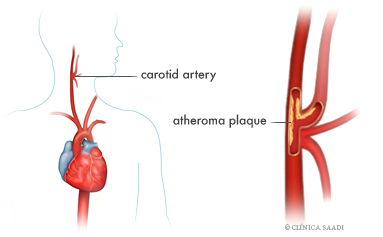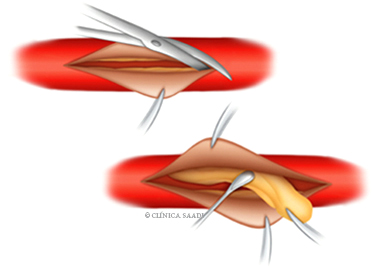Cardiovascular system Carotid diseases
Carotid diseases: The carotid arteries are vessels that begin in the aorta (in the thorax), course over the neck, and enter into the skull. They take blood to the brain. There can be an impairment to the brain circulation when they are compromised with atheroma (fat) plaques inside them, so causing transient ischemic accident (TIA) or stroke.

Usually no symptoms appear in the initial disease stages. It is important when there is a release of small thrombus fragments from such plaques or narrowings, as there can be signs such as: transient ischemic accident (TIA) or transient alterations (which range from some minutes to some hours), such as less of movement control in an arm or leg, transient vision loss, or difficulty in speaking. These symptoms usually disappear in up to 24 hours. A transient ischemic accident means high stroke risk and the physician must be contacted immediately. Stroke – brain injury caused by ischemia (lack of circulation), where death of brain cells occurs. There can be irreversible damage.
The diagnosis can be suspected by a neck auscultation, with the identification of a murmur in a carotid, which means a turbulent flow, usually caused by narrowing of the vessel lumen.
Imaging methods are needed to confirm the diagnosis and to set the severity. Echodoppler, magnetic angioresonance, and multislice angiotomography are the most used. An arteriography (catheterization) can be eventually necessary. Besides the diagnosis, these exams also serve to indicate the need and the intervention type.
* More information on the imaging methods described above can be found in Cardiovascular System > Exams.
Carotid diseases: Treatment
The treatment will depend of the stenosis (narrowing) degree and the symptoms. A clinical treatment with medicines (antiplatelet-aggregation drugs) and risk factor control is recommended in asymptomatic patients with non-significant stenoses.
Intervention-Procedure
Patients with symptoms clearly related to a carotid disease or even without symptoms, but with severe narrowings (mainly if in both carotids) must have a surgery or angioplasty with stent considered.
In a conventional operation, the surgeon removes the fat plaque (endarterectomy) by an incision on the neck.

In an angioplasty with stent, a catheter is placed inside the arterial system, the fat plaque is dilated, and a stent (metallic mesh) is placed inside the vessel.


